Copper-Bearing Mineralisation in the Upper Devonian Limestones: A Case Study from the Historical Teresa Adit in the Świętokrzyskie Mountains, Poland
Abstract
:1. Introduction
2. Outline of the History of Mineral Investigation in the Miedzianka Mountain Deposit
2.1. Exploitation of the Deposit
2.2. Minerals Described from the Deposit
2.3. The Origin of the Deposit
3. Study Area
4. Research Methods
5. Results
5.1. Characteristics of Devonian Limestones
5.2. Characteristics of Minerals from the Teresa Adit
5.2.1. Primary Minerals—Ore Mineralisation
5.2.2. Secondary Minerals in the Oxidised Zones
- a = 5.0150 ± 0.0063
- b = 5.8482 ± 0.0092
- c = 10.349 ± 0.012
- β = 92.48° ± 0.10
| Sample P7A2-1 green: | Sample P7A2-1 black: |
| a = 9.492 ± 0.027 | a = 9.493 ± 0.038 |
| b = 11.946 ± 0.025 | b = 11.943 ± 0.033 |
| c = 3.2441 ± 0.0082 | c = 3.243 ± 0.012 |
| β = 98.56° ± 0.20 | β = 98.55° ± 0.30 |
6. Discussion
7. Summary
Author Contributions
Funding
Data Availability Statement
Acknowledgments
Conflicts of Interest
References
- Kowalczewski, Z. Historia górnictwa świętokrzyskiego—Geologia złóż, dzieje eksploatacji, wykorzystanie kopalin. In Proceedings of the 42 Zjazd Polskiego Towarzystwa Geologicznego, Kielce, Poland, 27–30 June 1993; pp. 7–8, 24–32. [Google Scholar]
- Staszic, S. O Ziemiorództwie Karpatów i Innych Gór i Równin Polski. Warszawa, w Drukarni Rządowei, 1815, 107s. + Atlas. Available online: https://jbc.bj.uj.edu.pl/dlibra/doccontent?id=267 (accessed on 15 June 2021).
- Morozewicz, J. Staszycyt—Nowy minerał złoża kruszcowego na Miedziance (Staszicit, ein neues Mineral des Kupfererzvorkommens Miedzianka). In Rozprawy Akademii Umiejętności-Rozprawy Wydziału Matematyczno-Przyrodniczego; dział, A., Drukarnia, U.J., Eds.; Wielkopolska Biblioteka Cyfrowa: Poznań, Poland, 1919; Volume 18, pp. 123–134. [Google Scholar]
- Morozewicz, J. O kobaltowym minerale Miedzianki, lubeckicie. In Rozprawy Akademii Umiejętności-Rozprawy Wydziału Matematyczno-Przyrodniczego; dział, A., Drukarnia, U.J., Eds.; Wielkopolska Biblioteka Cyfrowa: Poznań, Poland, 1919; Volume 18, pp. 205–209. [Google Scholar]
- Czarnocki, J. Surowce mineralne w Górach Świętokrzyskich. Surowce skalne. Pract. Państwowego Instytutu Geol. 1958, 21, 128–160. [Google Scholar]
- Rubinowski, Z. Z badań złóż kruszców w Polsce. Biul. Inst. Geol. 1971, 247, 27–46, 105–132. [Google Scholar]
- Balcerzak, E.; Nejbert, K.; Olszyński, W. Nowe dane o paragenezach kruszcowych w żyłach siarczków pierwotnych złoża Miedzianka (Góry Świętokrzyskie). Przegląd Geol. 1992, 40, 659–663. [Google Scholar]
- Kozłowski, A. Native gold from Miedzianka Mt., Świętokrzyskie Mts. In Gold in Poland; Kozłowski, A., Mikulski, S.Z., Eds.; Uniwersytet Warszawski, Wydział Geologii, Państwowy Instytut Geologiczny, Państwowy Instytut Badawczy: Warszawa, Poland, 2011; Volume 2, pp. 339–349. [Google Scholar]
- Borowiecki, N.; Barzycki, M.; Chudzik, W. Możliwości zagospodarowania naturalnych i pogórniczych podziemi rezerwatu “Góra Miedzianka” do celów geoturystycznych. Bezp. Pract. Ochr. Sr. Gór. 2017, 275, 8–17. [Google Scholar]
- Ciurej, A.; Struska, M.; Wolska, A.; Chudzik, W. The Miedzianka Mountain Ore Deposit (Swiętokrzyskie Mountains, Poland) as a Site of Historical Mining and Geological Heritage: A Case Study of the Teresa Adit. Minerals 2021, 11, 1177. [Google Scholar] [CrossRef]
- Ciurej, A.; Struska, M.; Wolska, A.; Chudzik, W. Atrakcje geoturystyczne rejonu pogórniczego na przykładzie dawnej sztolni Teresa, Góra Miedzianka koło Chęcin. In Proceedings of the XXIX Konferencja Aktualia i Perspektywy Gospodarki Surowcami Mineralnymi, Nowy Sącz, Poland, 6–8 November 2019; pp. 15–17. [Google Scholar]
- Łabęcki, H. Górnictwo w Polsce: Opis Kopalnictwa i Hutnictwa Polskiego Pod Względem Technicznym, Historyczno-Statystycznym i Prawnym; Drukarnia Jana Kaczanowskiego: Warszawa, Poland, 1841; Volume 1, pp. 1–538. [Google Scholar]
- Morozewicz, J. O miedziankicie (On miedziankite). Spraw. Pol. Inst. Geol. 1924, 2, 1–3. [Google Scholar]
- Manecki, A. Encyklopedia Minerałów. Minerały Ziemi i Materii Kosmicznej; AGH, Uczelniane Wydawnictwa Naukowo-Dydaktyczne: Kraków, Poland, 2004; p. 498. [Google Scholar]
- Biagioni, C.; George, L.L.; Cook, N.J.; Makovicky, E.; Moëlo, Y.; Pasero, M.; Sejkora, J.; Stanley, C.J.; Welch, M.D.; Bosi, F. The tetrahedrite group: Nomenclature and classification. Am. Mineral. 2020, 105, 109–122. [Google Scholar] [CrossRef]
- Łaszkiewicz, A. Mimetyt z Miedzianki (Mimetite from Miedzianka). Arch. Mineral. 1928, 4, 133–135. [Google Scholar]
- Czarnocki, J. O budowie zachodniej części fałdu chęcińskiego. Posiedz. Nauk. Państw. Inst. Geol. 1928, 21, 52–55. [Google Scholar]
- Swęd, M.; Urbanek, P.; Krechowicz, I.; Dworczak, P.; Wiecka, P.; Mleczak, M.; Tobys, P. Mineralogia hałd wietrzeniowych złoża Miedzianka (Góry Świętokrzyskie). Przegląd Geol. 2015, 63, 363–372. [Google Scholar]
- Wróblewski, T. Rys historyczny górnictwa kruszcowego w Górach Świętokrzyskich. Przegląd Geol. 1962, 10, 414–417. [Google Scholar]
- Czarnocki, J. Ogólna Mapa Geologiczna Polski 1:100,000. Arkusz 4, Kielce; Państwowy Instytut Geologiczny: Warszawa, Poland, 1938. [Google Scholar]
- Wojciechowski, A. Hałdy dawnego górnictwa świętokrzyskiego jako źródło metali kolorowych i szlachetnych. Przegląd Geol. 2002, 50, 240–244. [Google Scholar]
- Szunke, M.; Kowalczewski, Z. Zjazdy Polskiego Towarzystwa Geologicznego w regionie świętokrzyskim. Przegląd Geol. 2006, 54, 509–512. [Google Scholar]
- Giełżecka-Mądry, D.; Fijałkowska-Mader, A.; Szczepanik, Z. Działalność Oddziału Świętokrzyskiego PIG-PIB w zakresie geologii środowiskowej, ochrony przyrody nieożywionej oraz edukacji geologicznej (Activity of the Holy Cross Mountains Branch of the Polish Geological Institute-NRI in the field of environmental geology, protection of inanimate nature and geological education). Przegląd Geol. 2021, 69, 250–258. [Google Scholar]
- Wieser, T.; Żabiński, W. Copper arsenate and sulphate minerals from Miedzianka near Kielce (Poland). Mineral. Pol. 1986, 17, 17–39. [Google Scholar]
- Bzowska, G.; Karwowski, Ł.; Juzaszek, A. New phosphate and arsenate minerals from Miedzianka near Chęciny (Holy Cross Mts.). Pol. Mineral. Soc.–Spec. Pap. 2003, 22, 201–204. [Google Scholar]
- Lenik, P.; Salwa, S.; Bazarnik, J. Ni,Co-pyrites (bravoites) from the Holy Cross Mountains, Poland. Mineral.–Spec. Pap. 2019, 49, 58. [Google Scholar]
- Lenik, P.; Salwa, S.; Bazarnik, J. Thiospinels (siegenite, fletcherite) from the Holy Cross Mountains, Poland—Preliminary results. Mineral.–Spec. Pap. 2019, 49, 59. [Google Scholar]
- Rubinowski, Z. Wyniki badań geologicznych w okolicy Miedzianki świętokrzyskiej. Biul. Inst. Geol. 1958, 126, 143–153. [Google Scholar]
- Rubinowski, Z. Nowe obserwacje okruszcowania na Miedziance świętokrzyskiej. Przegląd Geol. 1955, 6, 299–301. [Google Scholar]
- Urban, J. Bloczne skały węglanowe w Paleozoiku zachodniej części Gór Świętokrzyskich. Kwart. Geol. 1986, 31, 238–239. [Google Scholar]
- Ryka, W. Adinol contact in Bardo (Święty Krzyż Mountains). Kwart. Geol. 1957, 1, 163–167. [Google Scholar]
- Kardymowicz, I. Studia petrologiczne lamprofirów Gór Świętokrzyskich. Kwart. Geol. 1962, 6, 271–318. [Google Scholar]
- Rubinowski, Z. Lamprofiry okolic Daleszyc i związane z nimi przejawy mineralizacji. Kwart. Geol. 1962, 6, 245–269. [Google Scholar]
- Samsonowicz, J. Lamprofiry okolic Iwanisk Łysogórskich i okolic Siewierza. Pos. Nauk. Państw. Inst. Geol. 1928, 19–20, 38–39. [Google Scholar]
- Migaszewski, M.Z. Datowanie diabazu i lamprofirów świętokrzyskich metodą K-Ar i Ar-Ar. Przegląd Geol. 2002, 50, 227–229. [Google Scholar]
- Jaśkowski, B.; Kowalski, B.; Sołtysik, R. Góra Miedzianka—Budowa geologiczna i historia eksploatacji rud miedzi. In Proceedings of the Konferencja Naukowa nt. Geomorfologia Gór i Wyżyn w Polsce—Kontrowersje i Nowe Spojrzenia, Kielce, Poland, 16–19 May 2000; pp. 90–94. [Google Scholar]
- Morozewicz, J. O miedziankicie. Spraw. Pol. Inst. Geol. 1923, 2, 1–3. [Google Scholar]
- Bolewski, A. Mineralogia Szczegółowa; Wydawnictwa Geologiczne: Warszawa, Poland, 1965; p. 796. [Google Scholar]
- Czarnocki, J. Marmury świętokrzyskie. W: Materiały do znajomości skał w Polsce. Biul. Inst. Geol. 1952, 80, 27–48. [Google Scholar]
- Wojciechowski, J. Minerały Miedzianki pod Chęcinami. Pract. Muz. Ziemi 1958, 1, 133–156. [Google Scholar]
- Bolewski, A.; Manecki, A. Mineralogia Szczegółowa; Polska Agencja Ekologiczna: Warszawa, Poland, 1993; p. 663. [Google Scholar]
- Konon, A. Regionalizacja tektoniczna Polski–Góry Świętokrzyskie i regiony przyległe. Przegląd Geol. 2008, 56, 921–926. [Google Scholar]
- Recielski, K. Jaskinia w Sztolni Teresa na Miedziance. In Jaskinie Regionu Świętokrzyskiego; Urban, J., Ed.; PTPNoZ: Warszawa, Poland, 1996. [Google Scholar]
- Belokoneva, E.L.; Gubina, Y.K.; Forsyth, J.B. The charge density distribution and antiferromagnetic properties of azurite Cu3[CO3]2(OH)2. Phys. Chem. Miner. 2001, 28, 498–507. [Google Scholar] [CrossRef]
- Zigan, F.; Joswig, W.; Schuster, H.D.; Mason, S.A. Verfeinerung der struktur von Malachit, Cu2(OH)2CO3, durch neutronenbeugung. Z. Für Krist. 1977, 145, 412–426. [Google Scholar] [CrossRef]
- Kazmierczak, J. Morphogenesis and systematics of the Devonian Stromatoporoidea from the Holy Cross Mountains, Poland. Palaeont. Pol. 1971, 26, 1–150. [Google Scholar]
- Narkiewicz, M.; Racki, G.; Wrzołek, T. Litostratygrafia dewońskiej serii stromatoporoidowo-koralowcowej w Górach Świętokrzyskich. Kwart. Geolog. 1990, 34, 433–456. [Google Scholar]
- Racki, G. Evolution of the bank of reef complex in the Devonian of the Holy Cross Mountains. Acta Palaeont. Pol. 1993, 37, 87–182. [Google Scholar]
- Borkowska, M.; Smulikowski, K. Minerały Skałotwórcze; Wydawnictwo Geologiczne: Warszawa, Poland, 1973; p. 477. [Google Scholar]
- Kotański, Z. Z Plecakiem i Młotkiem w Góry Świętokrzyskie. Przewodnik Geologiczny Dla Turystów; Wydawnictwo Geologiczne: Warszawa, Poland, 1968; p. 227. [Google Scholar]
- Rubinowski, Z. Zarys Metalogenezy Paleozoiku Świętokrzyskiego. Przew. 35 Zjazdu. Pol. Tow. Geol. Kielce, 16–19 Września, 1962; PIG: Warszawa, Poland, 1962. [Google Scholar]
- Vink, B.W. Stability relations of malachite and azurite. Mineral. Mag. 1986, 50, 41–47. [Google Scholar] [CrossRef]
- Bąk, K.; Kowalczyk, J.; Wolska, A.; Bąk, M.; Natkaniec-Nowak, L. Iron and silica enrichments in the Middle Albian neptunian dykes from the High-Tatric Unit, Central Western Carpathians: An indication of hydrothermal activity for an extensional tectonic regime. Geol. Mag. 2018, 155, 1–19. [Google Scholar] [CrossRef]
- Bąk, M.; Górny, Z.; Bąk, K.; Wolska, A.; Stożek, B. Successive stages of calcitization and silicification of Cenomanian spicule-bearing turbidites based on microfacies analysis, Polish Outer Carpathians. Ann. Soc. Geol. Pol. 2015, 85, 187–203. [Google Scholar] [CrossRef] [Green Version]
- Migaszewski, M.Z.; Hałas, S.; Durakiewicz, T. Wiek i geneza mineralizacji kalcytowej w Górach Świętokrzyskich w świetle badań litologiczno-petrograficznych i izotopowych. Przegląd Geol. 1996, 44, 275–281. [Google Scholar]
- Bąk, K.; Bąk, M.; Gatlik, J.; Błachowski, A. Oscillating redox conditions in the Middle–Late Jurassic Alpine Tethys: Insights from selected geochemical indices and 57Fe Mössbauer spectroscopy. Palaeogeogr. Palaeoclimatol. Palaeoecol. 2020, 537, 109440. [Google Scholar] [CrossRef]
- Voudouris, P.; Melfos, V.; Mavrogonatos, C.; Photiades, A.; Moraiti, E.; Rieck, B.; Zaimis, S. The Lavrion Mines: A Unique Site of Geological and Mineralogical Heritage. Minerals 2021, 11, 76. [Google Scholar] [CrossRef]
- Gioncada, A.; Pitzalis, E.; Cioni, R.; Fulignati, P.; Lezzerini, M.; Mundula, F.; Funedda, A. The volcanic and mining geoheritage of San Pietro Island (Sulcis, Sardinia, Italy): The potential for geosite valorization. Geoheritage 2019, 11, 1567–1581. [Google Scholar] [CrossRef]
- Marescotti, P.; Brancucci, G.; Sasso, G.; Solimano, M.; Marin, V.; Muzio, C.; Salmona, P. Geoheritage values and environmental issues of derelict mines: Examples from the sulphides mines of Gromolo and Petronio valleys (Eastern Liguria, Italy). Minerals 2018, 8, 229. [Google Scholar] [CrossRef] [Green Version]
- Wiewiórka, J. Level of the oldest rock-salt in the stratified salt deposit of Wieliczka. Stud. I Mater. Do Dziejów Żup Solnych W Polsce 1974, 3, 17–38. [Google Scholar]
- Aulický, R.; Iványi, K.; Kafka, J. Rudné a Uranové Hornictví České Republiky; Anagram: Ostrava, Czech Republic, 2003; p. 647. [Google Scholar]
- Stockmann, M.; Hirsch, D.; Lippmann-Pipke, J.; Kupsch, H. Geochemical study of different-aged mining dump materials in the Freiberg mining district, Germany. Environ. Earth Sci. 2012, 68, 1153–1168. [Google Scholar] [CrossRef]
- Sidor, C.; Kršák, B.; Štrba, Ľ.; Gajdoš, J.; Šebešová, A.; Kolačkovska, J. Examples of secondary online data for raising awareness about geo and mining heritage. Acta Montan. Slovaca 2020, 25, 116–126. [Google Scholar]
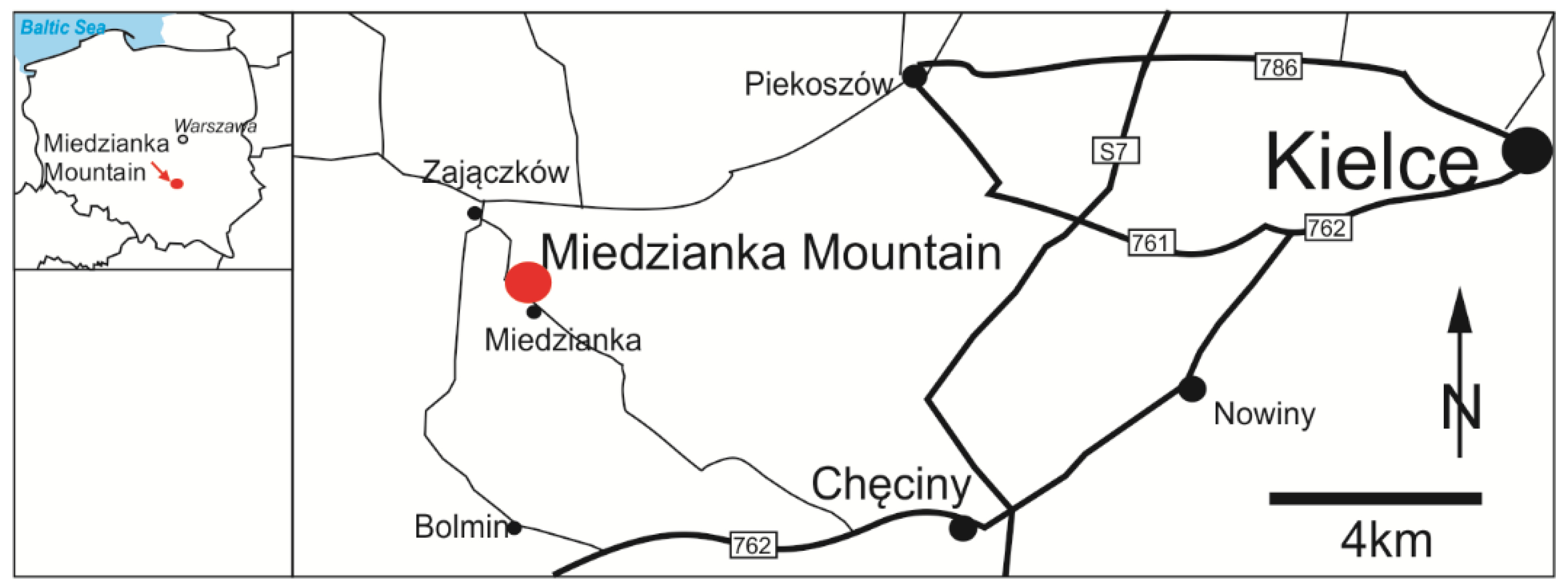
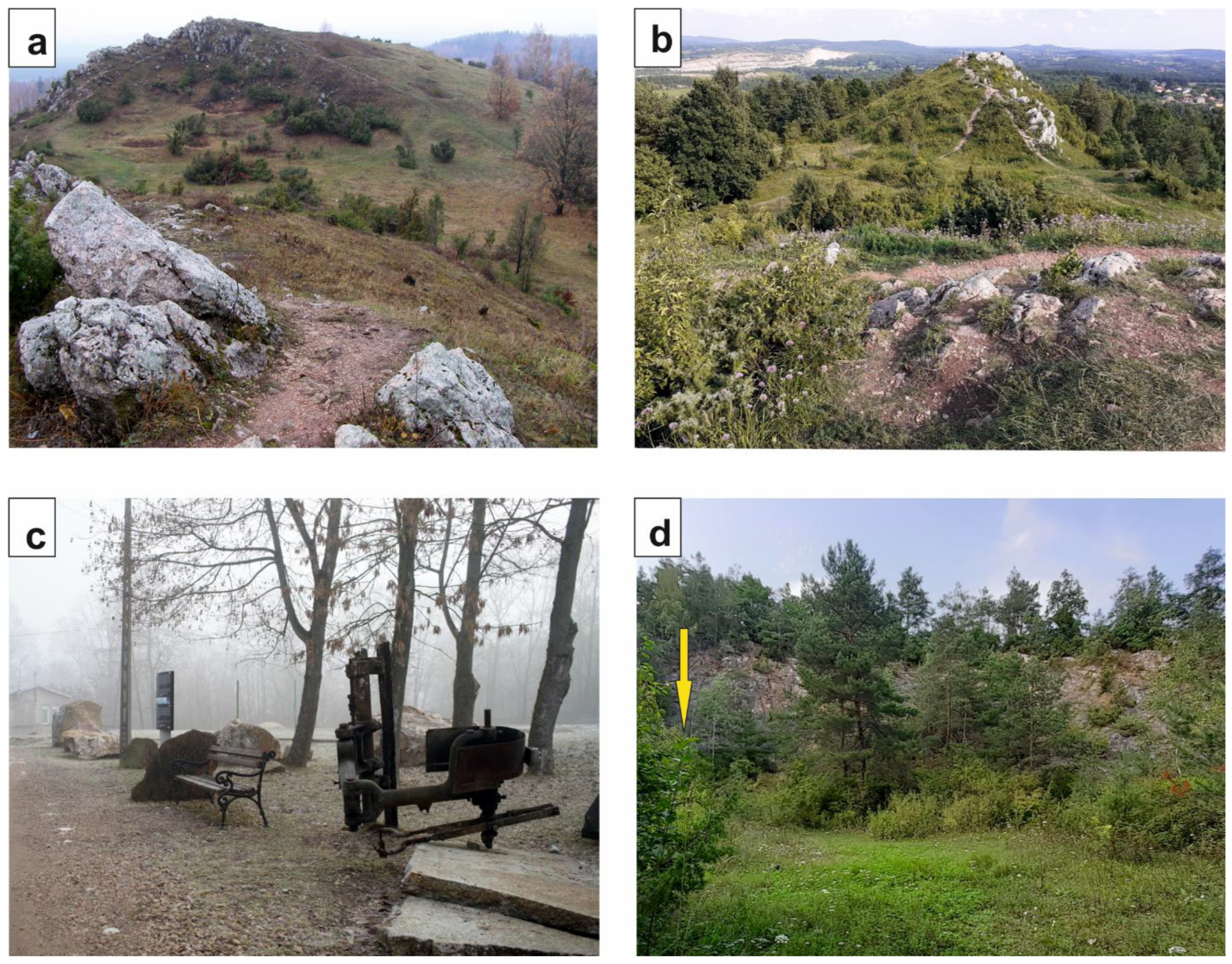
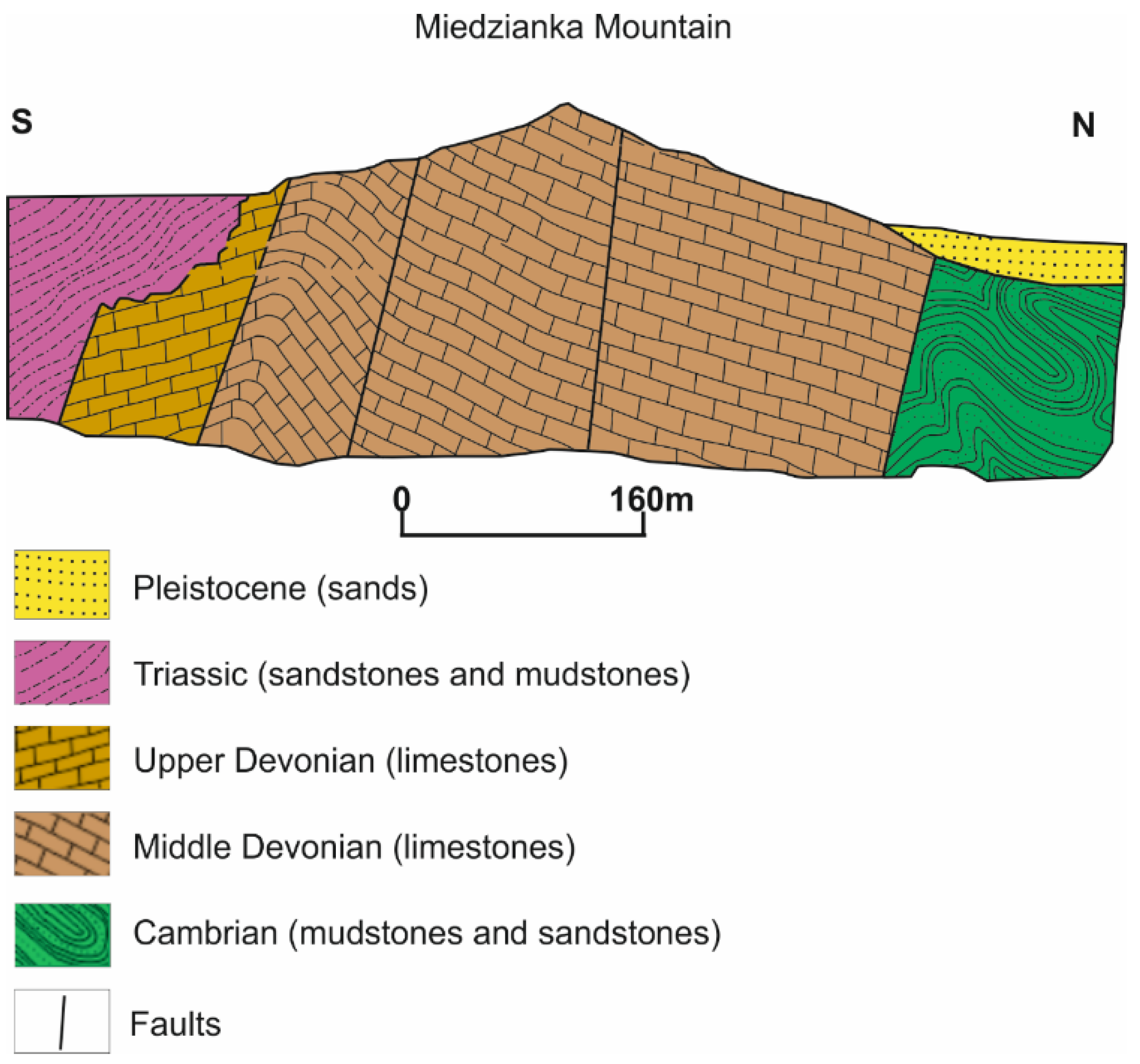
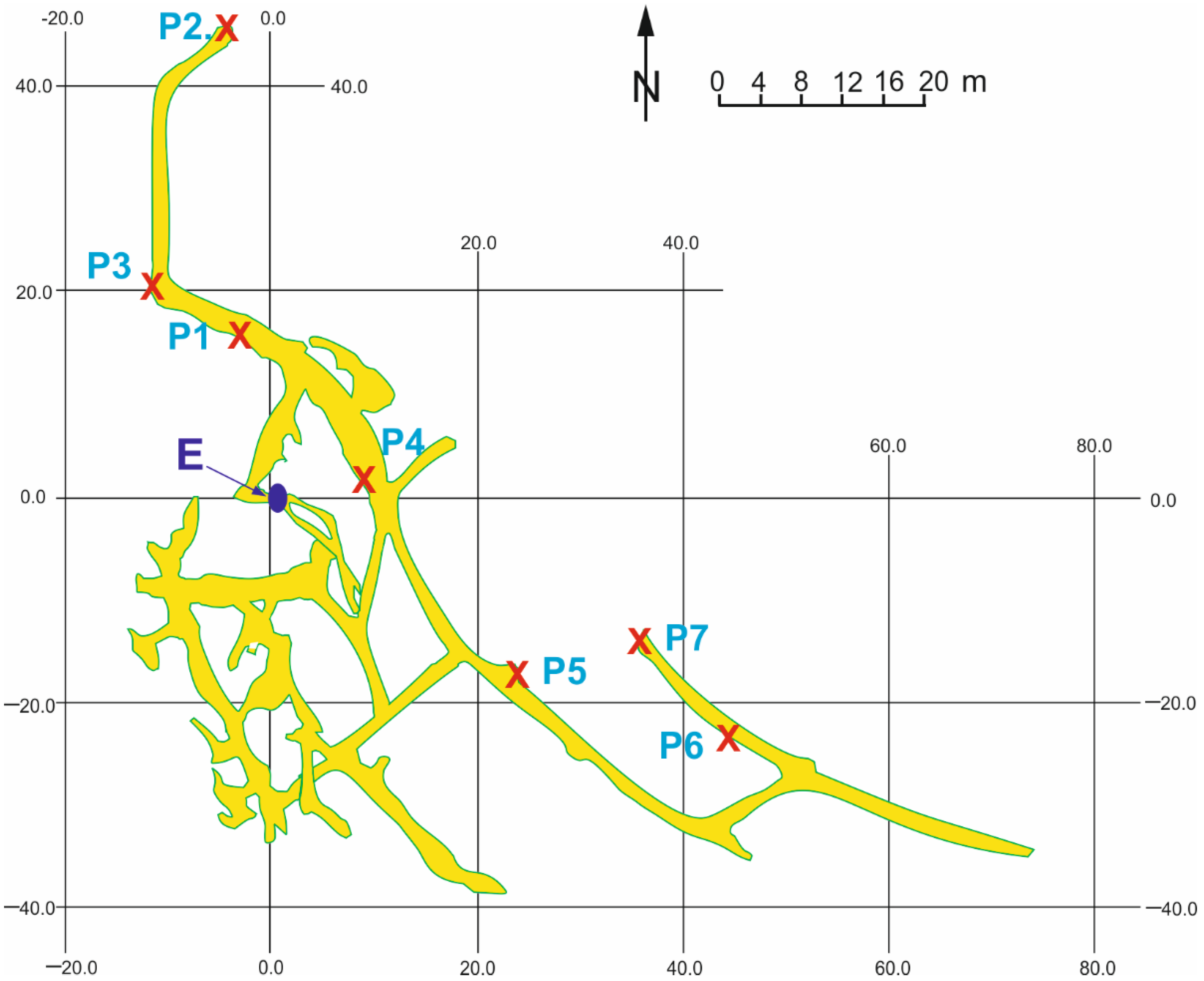

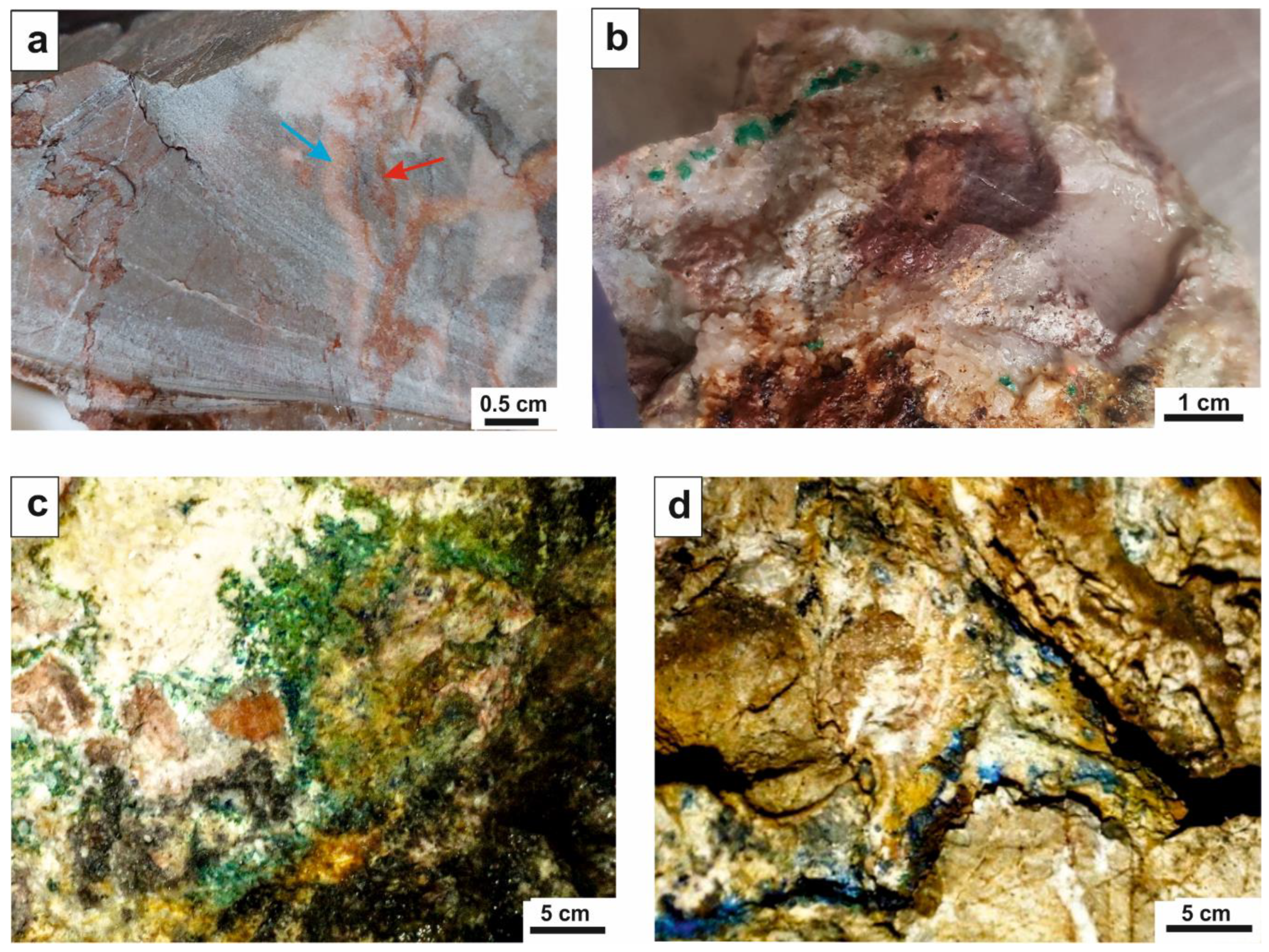
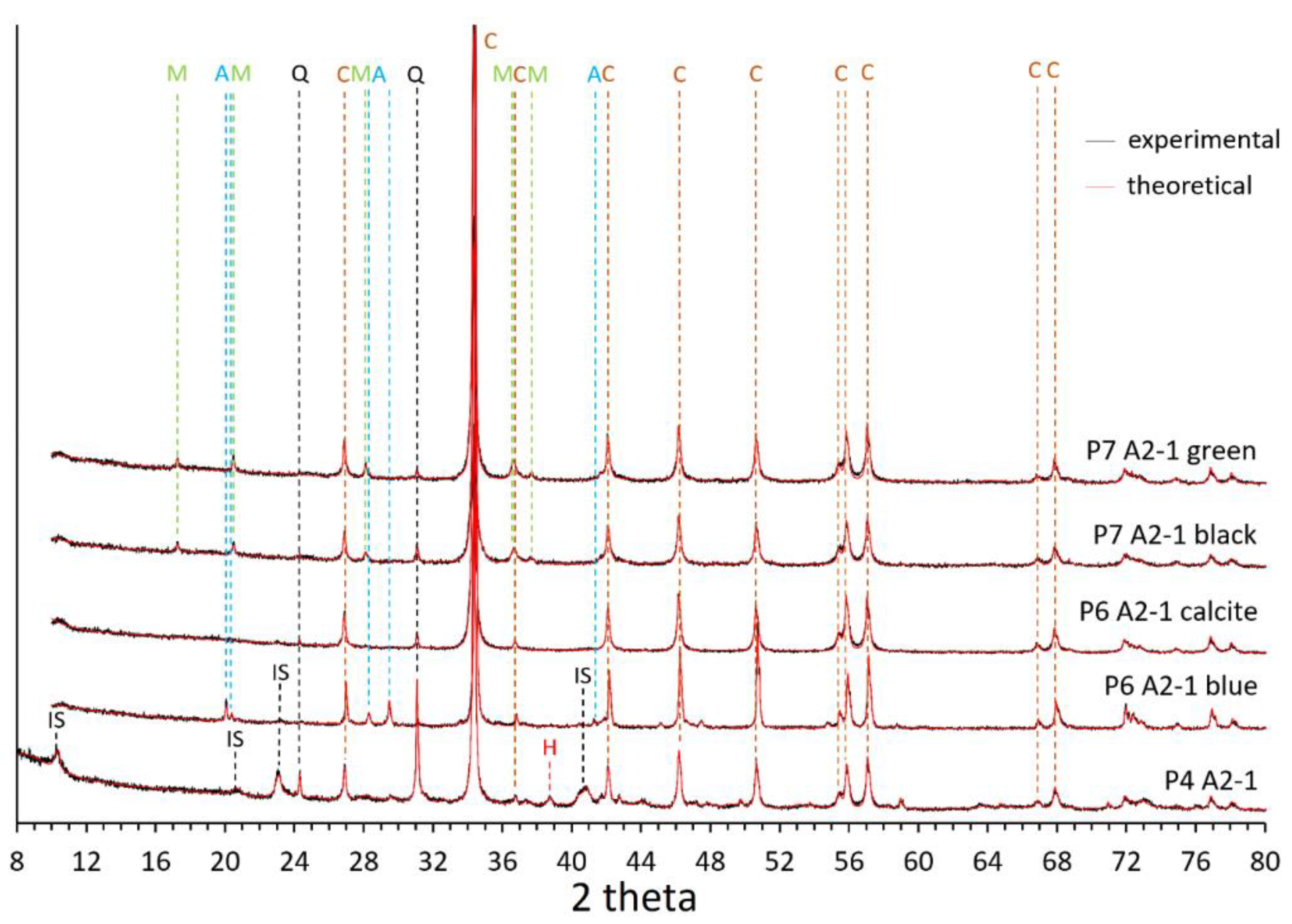
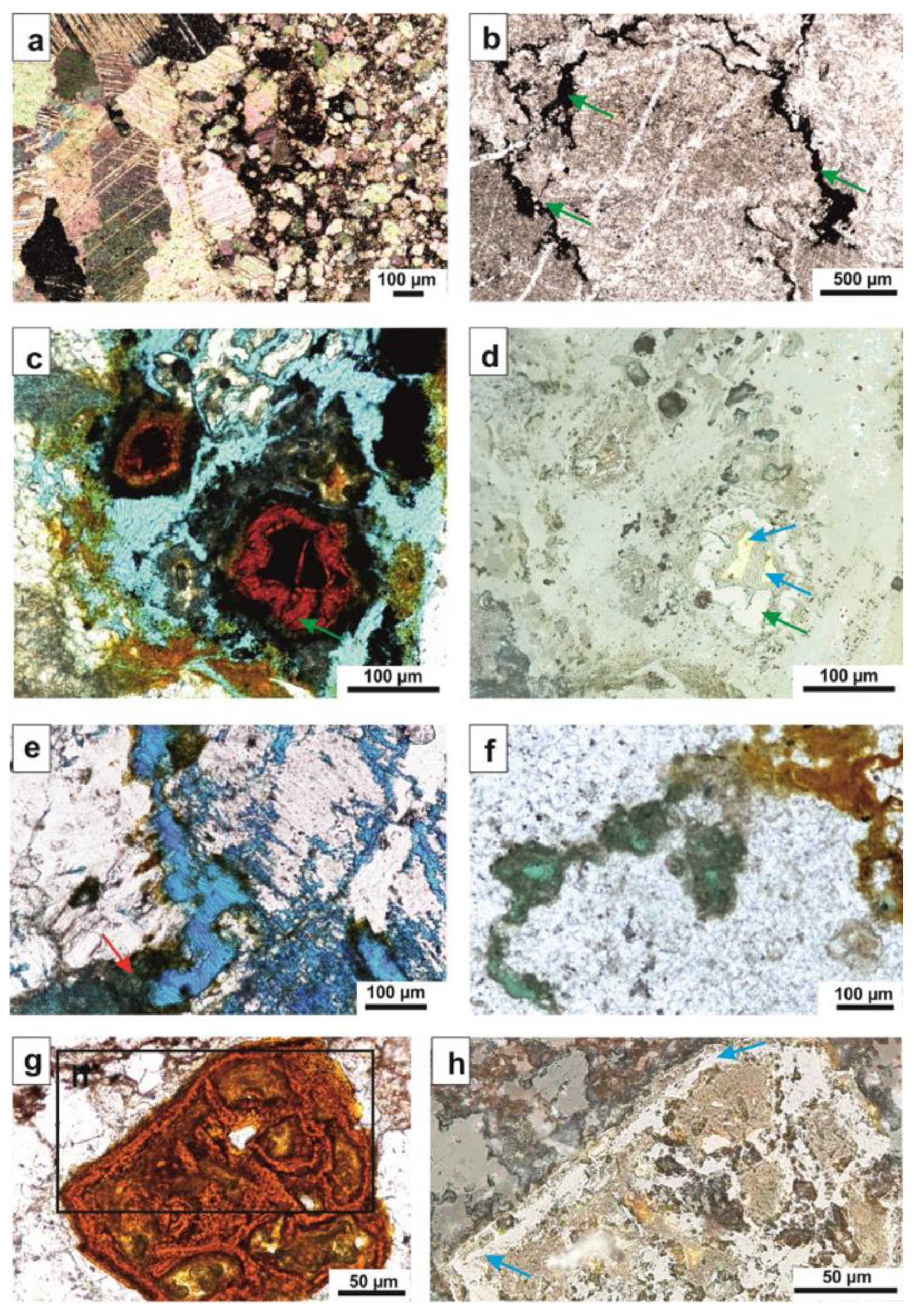
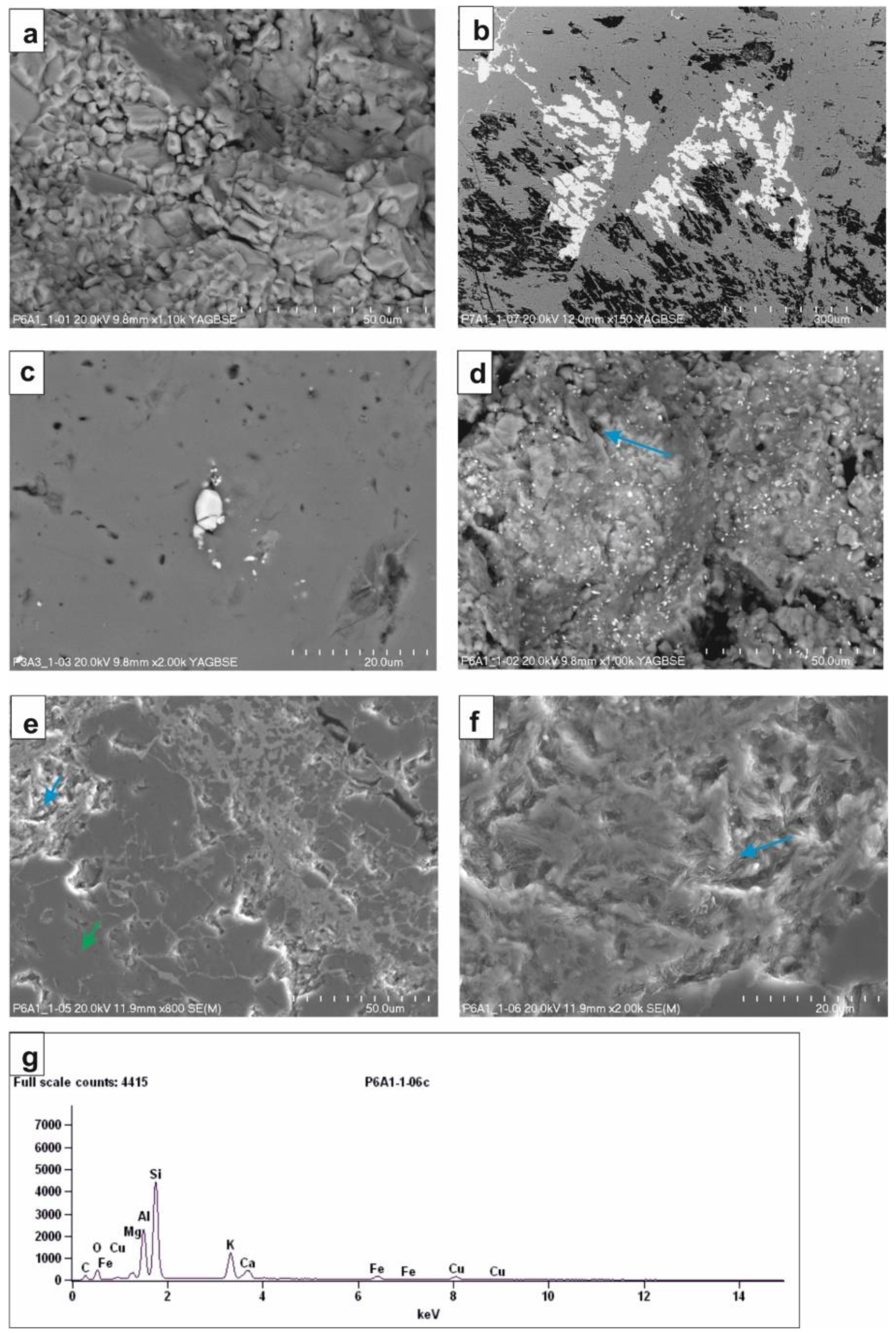

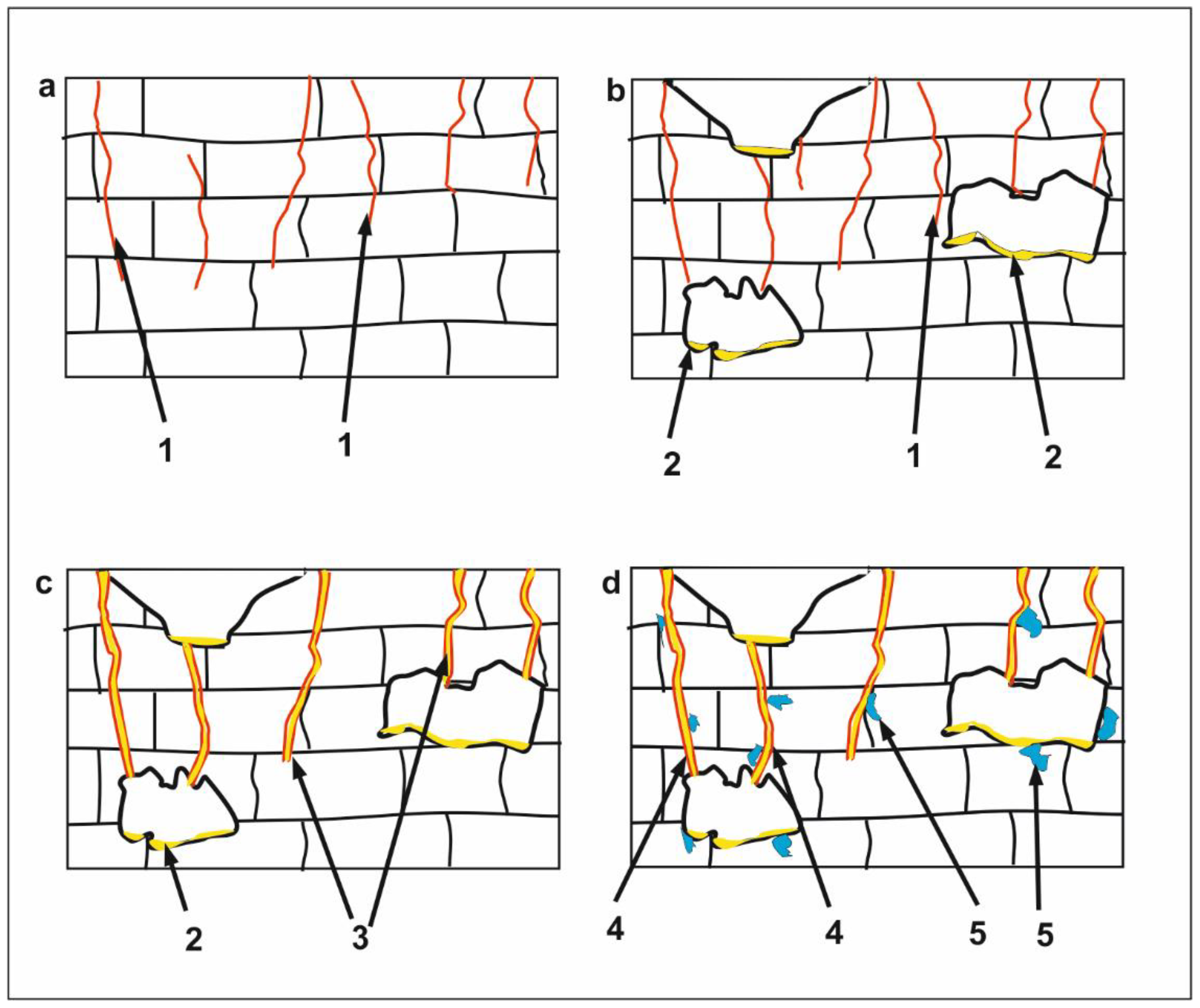
| Sample | Quartz | Calcite | Azurite | Malachite | Mica/Illite | Hematite | Siderite | SUM |
|---|---|---|---|---|---|---|---|---|
| P4A2-1 | 8.1 | 40.3 | 0.8 | 47.7 | 2.5 | 0.6 | 100.0 | |
| P6A2-1 calcite | 2.5 | 97.5 | 100.0 | |||||
| P6A2-1 blue | 0.4 | 85.5 | 8.8 | 5.3 | 100.0 | |||
| a = 5.0150 ± 0.0063 (5.011) | ||||||||
| b = 5.8482 ± 0.0092 (5.850) | ||||||||
| c = 10.349 ± 0.012 (10.353) | ||||||||
| β = 92.48° ± 0.10 (92.41) | ||||||||
| P7A1-1 green | 1.3 | 87.9 | 10.8 | 100.0 | ||||
| a = 9.492 ± 0.027 (9.502) | ||||||||
| b = 11.946 ± 0.025 (11.974) | ||||||||
| c = 3.2441 ± 0.0082 (3.240) | ||||||||
| β = 98.56° ± 0.20 (98.75) | ||||||||
| P7A1-1 black | 3.0 | 89.0 | 8.0 | 100.0 | ||||
| a = 9.493 ± 0.038 (9.502) | ||||||||
| b = 11.943 ± 0.033 (11.974) | ||||||||
| c = 3.243 ± 0.012 (3.240) | ||||||||
| β = 98.55° ± 0.30 (98.75) |
| Phase | 2 Theta (Co) | Relative Intensity | D-Spacing | hkl |
|---|---|---|---|---|
| Malachite | 17.18 | 48.11 | 5.9870 | 020 |
| 20.41 | 67.53 | 5.0484 | 120 | |
| 28.02 | 68.15 | 3.6948 | 220 | |
| 36.51 | 100.00 | 2.8556 | −201 | |
| 37.57 | 43.29 | 2.7777 | −211 | |
| Azurite | 19.92 | 61.54 | 5.1719 | 002 |
| 20.23 | 29.12 | 5.0921 | 011 | |
| 28.17 | 55.14 | 3.6753 | −102 | |
| 29.33 | 100.00 | 3.5336 | 111 | |
| 41.14 | 26.31 | 2.5460 | 022 |
Disclaimer/Publisher’s Note: The statements, opinions and data contained in all publications are solely those of the individual author(s) and contributor(s) and not of MDPI and/or the editor(s). MDPI and/or the editor(s) disclaim responsibility for any injury to people or property resulting from any ideas, methods, instructions or products referred to in the content. |
© 2022 by the authors. Licensee MDPI, Basel, Switzerland. This article is an open access article distributed under the terms and conditions of the Creative Commons Attribution (CC BY) license (https://creativecommons.org/licenses/by/4.0/).
Share and Cite
Ciurej, A.; Struska, M.; Wolska, A.; Szczerba, M.; Olszak, J. Copper-Bearing Mineralisation in the Upper Devonian Limestones: A Case Study from the Historical Teresa Adit in the Świętokrzyskie Mountains, Poland. Minerals 2023, 13, 54. https://doi.org/10.3390/min13010054
Ciurej A, Struska M, Wolska A, Szczerba M, Olszak J. Copper-Bearing Mineralisation in the Upper Devonian Limestones: A Case Study from the Historical Teresa Adit in the Świętokrzyskie Mountains, Poland. Minerals. 2023; 13(1):54. https://doi.org/10.3390/min13010054
Chicago/Turabian StyleCiurej, Agnieszka, Monika Struska, Anna Wolska, Marek Szczerba, and Janusz Olszak. 2023. "Copper-Bearing Mineralisation in the Upper Devonian Limestones: A Case Study from the Historical Teresa Adit in the Świętokrzyskie Mountains, Poland" Minerals 13, no. 1: 54. https://doi.org/10.3390/min13010054
APA StyleCiurej, A., Struska, M., Wolska, A., Szczerba, M., & Olszak, J. (2023). Copper-Bearing Mineralisation in the Upper Devonian Limestones: A Case Study from the Historical Teresa Adit in the Świętokrzyskie Mountains, Poland. Minerals, 13(1), 54. https://doi.org/10.3390/min13010054








